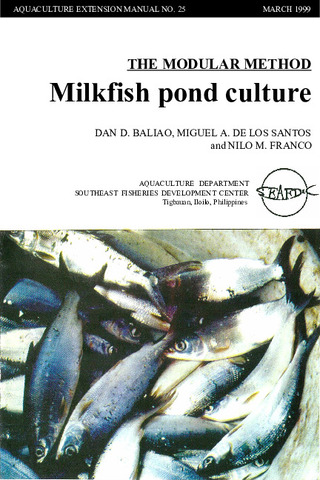Effect of feeding rate on the survival and growth of milkfish (Chanos chanos) fry in a controlled environment
- Global styles
- MLA
- Vancouver
- Elsevier - Harvard
- APA
- Help

Date
1978Author
Page views
3,035ASFA keyword
AGROVOC keyword
Taxonomic term
Metadata
Show full item record
Share
Abstract
The optimum daily feed allowance varies with species, age, size, frequency of feeding, culture procedures, quality of feed and water quality. This experiment indicated that with a diet containing 40% protein and 3,450 kcal of M.E. per kg, a feeding rate of 16-20% of the biomass is optimum for satisfactory survival and growth of fry raised in a controlled environment. Increasing the feeding level beyond this value was not beneficial but in turn increased the ammonia-nitrogen concentration to a level which is harmful to the fish.
Suggested Citation
Lim, C. (1978). Effect of feeding rate on the survival and growth of milkfish (Chanos chanos) fry in a controlled environment. SEAFDEC Aquaculture Department Quarterly Research Report , 2(4), 17-20. http://hdl.handle.net/10862/2336
Type
ArticleCollections
Related items
Showing items related by title, author, creator and subject.
-
Series: Aquaculture extension manual; No. 25
The modular method: Milkfish pond culture
Baliao, Dan D.; de los Santos, Miguel A.; Franco, Nilo M. (Aquaculture Department, Southeast Asian Fisheries Development Center, 1999)The modular method of milkfish culture (Chanos chanos) described in the manual is an improvement over the traditional extensive method. The manual is intended for the use of fish farmers and aquaculturists, extensionists, ... -
Evaluation of organic and inorganic fertilizers in brackishwater milkfish ponds
Bombeo-Tuburan, Isidra; Agbayani, Renato F.; Subosa, Precilla F. (Elsevier, 1989)The study was conducted in twelve 144-m2 ponds to evaluate the effect of different organic and inorganic fertilizers on the growth, survival, gross production, and profitability of marketable milkfish. The ... -
Milkfish breeding and hatchery technology at SEAFDEC/AQD
Unknown author (Aquaculture Department, Southeast Asian Fisheries Development Center, 1999)Describes the techniques already adopted by the private sector: broodstock management, broodstock diet, commercial fry production, live transport, and larval diet. A list of AQD research publications on milkfish is included.






